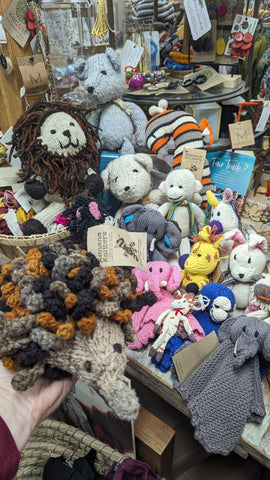Main photo credit: https://www.kenanaknitters.com/
Sustainability is a term often used loosely by organizations, but for us, it holds deep meaning and purpose. As advocates of Fair Trade, we believe in staying committed to the groups we choose to support. In our business, we have sold the same toys for over a decade, and this decision is rooted in our unwavering dedication to sustainability.
While some businesses constantly chase after the latest trends and profit opportunities, we have consciously made the choice to stand by the Fair Trade groups we work with. We understand that true sustainability goes beyond fleeting fads and quick gains. It is about building lasting partnerships and creating a positive impact on the lives of artisans and communities. Such as the remarkable grassroots organization known as Kenana Knitters. A group established in the heart of Kenya's Rift Valley. Founded in 1998 by the visionary Patricia Nightingale, a local Kenyan with a passion for uplifting her community, Kenana Knitters has become a beacon of hope and empowerment for women in the region.
At its inception, Kenana Knitters aimed to address a pressing issue faced by local ladies—the lack of a market for their homespun wool. Patricia recognized the immense potential hidden within the vibrant threads and embarked on a mission to transform them into unique creations. Through the power of clever designs and skilled craftsmanship, she and the dedicated knitters turned simple yarn into exquisite pieces of art.
However, Patricia's vision extended far beyond creating beautiful products. She understood the importance of community impact and sought to empower women by teaching them the art of knitting using local, sustainable resources such as organic cotton. With this approach, Kenana Knitters not only nurtured creativity but also nurtured a sense of pride and dignity among the women.
Today, Kenana Knitters boasts an impressive roster of 580 registered knitters, with 430 actively involved in the organization. Supporting these talented artisans are over 200 spinners, who ensure a steady supply of homespun wool. The impact of their work reaches far and wide, as the organization exports its collection of unique products to countries across Africa, Europe, the UK, USA, Japan, and Australia.
But Kenana Knitters' commitment to its artisans extends beyond just providing a livelihood. The organization recognizes the importance of holistic well-being and takes concrete steps to support the women in various aspects of their lives. A monthly health clinic offers vital services, including free eye checks and glasses if needed, while respecting the privacy of each individual by refraining from inquiring about their HIV status. Additionally, Kenana Knitters provides a savings plan, ensuring that the women have a safety net for the future. Daily newspapers and access to free electricity for phone and torch charging further contribute to their overall well-being.
Stitch by stitch, the Kenana Knitters are changing lives and empowering women in their community. What started as a small initiative to create a market for homespun wool has blossomed into a remarkable movement that uplifts individuals, families, and the entire region. The organization's impact reaches beyond economic empowerment; it fosters a sense of belonging, self-reliance, and pride among the women involved.
Kenana Knitters stands as a testament to the power of grassroots initiatives and the incredible transformations they can achieve. By supporting local talent and utilizing sustainable resources, this organization not only creates beautiful products but also creates a brighter future for the women it serves. Through their dedication, creativity, and unwavering spirit, the Kenana Knitters have woven a tapestry of empowerment, hope, and resilience—a tapestry that continues to grow with every stitch.
By remaining steadfast in our commitment, we contribute to the survival and growth of these Fair Trade groups. We are not simply interested in maximizing profits; our goal is to support and uplift these artisans so that they can thrive in the long run. We understand that their success is intertwined with our own, and by choosing sustainability, we choose a future where everyone benefits.
The decision to stick with the same toys for over a decade is not a stagnant one. It is a conscious choice to foster stability, trust, and mutual growth. We have witnessed firsthand the incredible craftsmanship and dedication of the artisans we work with. Their skills have been honed over time, and their creations embody the beauty of tradition and the essence of sustainable practices.
Through our unwavering support, we become advocates for these groups. We showcase their products, share their stories, and educate our customers about the significance of Fair Trade. By doing so, we help create a market for their goods, ensuring a steady income and sustainable livelihoods for the artisans and their families.
Our commitment to sustainability goes beyond financial gains. It is about preserving cultural heritage, promoting ethical practices, and fostering long-term relationships built on trust and respect. We understand that by standing by the Fair Trade groups we choose, we become a force for positive change in a world that often prioritizes profit over people.
So, while other businesses may jump from trend to trend, we choose to remain rooted in our mission. We believe in the power of consistency, integrity, and sustainability. By working hand in hand with producers like Kenana Knitters, we contribute to a future where artisans can continue their craft, communities can flourish, and ethical practices become the norm.
Together, let us be champions of sustainability, forging a path that uplifts and empowers artisans around the world. Through our choices and actions, we can create a world where Fair Trade is not just a buzzword, but a living, breathing testament to a more equitable and sustainable future for all.
Together we can change the world!
Lots of Love,
Yvie xoxoxo
Ps Can't do this without you! So thankyou for sharing this vision and supporting what we do.















